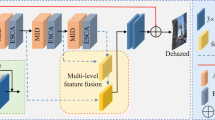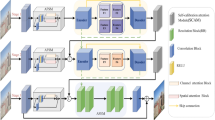Abstract
Haze reduces the imaging effectiveness of outdoor vision systems, significantly degrading the quality of images; hence, reducing haze has been a focus of many studies. In recent years, decoupled representation learning has been applied in image processing; however, existing decoupled networks lack a specific design for information with different characteristics to achieve satisfactory results in dehazing tasks. This study proposes a heterogeneous decoupling unsupervised dehazing network (HDUD-Net). Heterogeneous modules are used to learn the content and haze information of images individually to separate them effectively. To address the problem of information loss when extracting the content from hazy images with complex noise, this study proposes a bi-branch multi-hierarchical feature fusion module. Additionally, it proposes a style feature contrast learning method to generate positive and negative sample queues and construct contrast loss for enhancing decoupling performance. Numerous experiments confirm that the proposed algorithm achieves higher performance according to objective metrics and a more realistic visual effect when compared with state-of-the-art single-image dehazing algorithms.









Similar content being viewed by others
Data availability
The datasets generated and analyzed during the current study are available from the corresponding author on reasonable request.
References
Yang Y, Wang C, Liu R, Zhang L, Guo X, Tao D (2022) Self-augmented unpaired image dehazing via density and depth decomposition. In: 2022 IEEE/CVF conference on computer vision and pattern recognition (CVPR), pp 2027–2036
Wu Y, Tao D, Zhan Y, Zhang C (2022) Bin-flow: bidirectional normalizing flow for robust image dehazing. IEEE Trans Image Process 31:6635–6648
Chen J, Yang G, Xia M, Zhang D (2022) From depth-aware haze generation to real-world haze removal. Neural Comput Appl 1–13
Gao X, Tang P, Cheng Q, Li J (2022) Air infrared small target local dehazing based on multiple-factor fusion cascade network. Neural Comput Appl 1–9
Sun H, Zhang Y, Chen P, Dan Z, Sun S, Wan J, Li W (2021) Scale-free heterogeneous cyclegan for defogging from a single image for autonomous driving in fog. Neural Comput Appl 1–15
Mccartney EJ, Hall FF (1976) Optics of the atmosphere: scattering by molecules and particles. Phys Today 30:76–77
He K, Jian S, Fellow IEEE, Tang X (2011) Single image haze removal using dark channel prior. IEEE Trans Pattern Anal Mach Intell 33(12):2341–2353
Fattal R (2014) Dehazing using color-lines. ACM Trans Graph (TOG) 34(1):1–14
Zhu Q, Mai J, Shao L (2014) Single image dehazing using color attenuation prior. In: BMVC
Berman D, Treibitz T, Avidan S (2020) Single image dehazing using haze-lines. IEEE Trans Pattern Anal Mach Intell 42:720–734
Bui TM, Kim W (2018) Single image dehazing using color ellipsoid prior. IEEE Trans Image Process 27:999–1009
Ju M, Ding C, Guo YJ, Zhang D-Y (2020) IDGCP: image dehazing based on gamma correction prior. IEEE Trans Image Process 29:3104–3118
Ju M, Ding C, Guo CA, Ren W, Tao D (2021) IDRLP: image dehazing using region line prior. IEEE Trans Image Process 30:9043–9057
Cai B, Xu X, Jia K, Qing C, Tao D (2016) Dehazenet: an end-to-end system for single image haze removal. IEEE Trans Image Process 25:5187–5198
Li B, Peng X, Wang Z, Xu J, Feng D (2017) Aod-net: All-in-one dehazing network. In: 2017 IEEE international conference on computer vision (ICCV), pp 4780–4788
Zhao S, Zhang L, Shen Y, Zhou Y (2021) Refinednet: a weakly supervised refinement framework for single image dehazing. IEEE Trans Image Process
Li B, Gou Y, Liu JZ, Zhu H, Peng X (2020) Zero-shot image dehazing. IEEE Trans Image Process
Li B, Gou Y, Gu S, Liu J, Zhou JT, Peng X (2021) You only look yourself: unsupervised and untrained single image dehazing neural network. Int J Comput Vis 129:1754–1767
Shao Y, Li L, Ren W, Gao C, Sang N (2020) Domain adaptation for image dehazing. In: 2020 IEEE/CVF conference on computer vision and pattern recognition (CVPR), pp 2805–2814
Li L, Dong Y, Ren W, Pan J, Gao C, Sang N, Yang M-H (2020) Semi-supervised image dehazing. IEEE Trans Image Process 29:2766–2779
Chen Z, Wang Y, Yang Y, Liu D (2021) PSD: principled synthetic-to-real dehazing guided by physical priors. In: 2021 IEEE/CVF conference on computer vision and pattern recognition (CVPR), pp 7176–7185
Liu Y, Zhu L, Pei S, Fu H, Qin J, Zhang Q, Wan L, Feng W (2021) From synthetic to real: Image dehazing collaborating with unlabeled real data. In: Proceedings of the 29th ACM international conference on multimedia
Agrawal SC, Jalal AS (2022) Dense haze removal by nonlinear transformation. IEEE Trans Circuits Syst Video Technol 32:593–607
Ju M, Ding C, Ren W, Yang Y (2022) IDBP: image dehazing using blended priors including non-local, local, and global priors. IEEE Trans Circuits Syst Video Technol 32:4867–4871
Hong M, Xie Y, Li C, Qu Y (2020) Distilling image dehazing with heterogeneous task imitation. In: 2020 IEEE/CVF conference on computer vision and pattern recognition (CVPR), pp 3459–3468
Liu X, Zhang T, Zhang J (2022) Toward visual quality enhancement of dehazing effect with improved cycle-gan. Neural Comput Appl 1–14
Engin D, Genç A, Ekenel HK (2018) Cycle-dehaze: Enhanced cyclegan for single image dehazing. In: 2018 IEEE/CVF conference on computer vision and pattern recognition workshops (CVPRW), pp 938–9388
Liu M-Y, Breuel TM, Kautz J (2017) Unsupervised image-to-image translation networks. ArXiv arXiv:1703.00848
Hermans A, Beyer L, Leibe B (2017) In defense of the triplet loss for person re-identification. ArXiv arXiv:1703.07737
Berman D, Treibitz T, Avidan S (2016) Non-local image dehazing. In: 2016 IEEE conference on computer vision and pattern recognition (CVPR)
Zhu Q, Mai J, Shao L (2015) A fast single image haze removal algorithm using color attenuation prior. IEEE Trans Image Process 24:3522–3533
Tarel J-P, Hautiére N (2009) Fast visibility restoration from a single color or gray level image. In: 2009 IEEE 12th international conference on computer vision, pp 2201–2208
Hénaff O, Srinivas A, Fauw JD, Razavi A, Doersch C, Eslami S, Oord A (2019) Data-efficient image recognition with contrastive predictive coding
Dong H, Pan J, Xiang L, Hu Z, Zhang X, Wang F, Yang M-H (2020) Multi-scale boosted dehazing network with dense feature fusion. In: 2020 IEEE/CVF conference on computer vision and pattern recognition (CVPR), pp 2154–2164
Qin X, Wang Z, Bai Y, Xie X, Jia H (2020) FFA-Net: feature fusion attention network for single image dehazing. In: AAAI
Zhang C, Wu, C (2022) Multi-scale attentive feature fusion network for single image dehazing. In: 2022 International joint conference on neural networks (IJCNN), pp 1–7
Ronneberger O, Fischer P, Brox T (2015) U-net: convolutional networks for biomedical image segmentation. ArXiv arXiv:1505.04597
Lin C, Rong X, Yu X (2022) Msaff-net: multiscale attention feature fusion networks for single image dehazing and beyond. IEEE Trans Multimed
Yi X, Ma B, Zhang Y, Liu L, Wu JH (2022) Two-step image dehazing with intra-domain and inter-domain adaptation. Neurocomputing 485:1–11
Yi W, Dong L, Liu M, Zhao Y, Hui M, Kong L (2022) DCNet: dual-cascade network for single image dehazing. Neural Comput Appl 34(19):16771–16783
Tian Y, Krishnan D, Isola P (2020) Contrastive multiview coding. In: ECCV
Ren W, Ma L, Zhang J, Pan J, Cao X, Liu W, Yang M-H (2018) Gated fusion network for single image dehazing. In: 2018 IEEE/CVF conference on computer vision and pattern recognition, pp 3253–3261
Gutmann M, Hyvrinen A (2010) Noise-contrastive estimation: a new estimation principle for unnormalized statistical models. In: International conference on artificial intelligence and statistics
Zhang H, Patel VM (2018) Densely connected pyramid dehazing network. In: 2018 IEEE/CVF conference on computer vision and pattern recognition, pp 3194–3203
Chen X, Pan J, Jiang K, Li Y, Huang Y, Kong C, Dai L, Fan Z-C (2021) Unpaired deep image deraining using dual contrastive learning
Zhu H, Peng X, Chandrasekhar VR, Li L, Lim J-H (2018) Dehazegan: when image dehazing meets differential programming. In: IJCAI
Yang X, Xu Z, Luo J (2018) Towards perceptual image dehazing by physics-based disentanglement and adversarial training. In: AAAI
Ye Y, Chang Y, Zhou H, Yan L (2021) Closing the loop: joint rain generation and removal via disentangled image translation
Zhang Y, Li M, Li R, Jia K, Zhang L (2022) Exact feature distribution matching for arbitrary style transfer and domain generalization. In: 2022 IEEE/CVF conference on computer vision and pattern recognition (CVPR), pp 8025–8035
Zhang Y-X, Tang F, Dong W, Huang H, Ma C, Lee T-Y, Xu C (2022) Domain enhanced arbitrary image style transfer via contrastive learning. In: ACM SIGGRAPH 2022 conference proceedings
Simonyan K, Zisserman A (2014) Very deep convolutional networks for large-scale image recognition. Comput Sci
Li B, Ren W, Fu D, Tao D, Feng D, Zeng W, Wang Z (2019) Benchmarking single-image dehazing and beyond. IEEE Trans Image Process 28:492–505
Zhang Y, Ding L, Sharma G (2017) Hazerd: an outdoor scene dataset and benchmark for single image dehazing. In: 2017 IEEE international conference on image processing (ICIP), 3205–3209
Yang Y, Wang C, Liu R, Zhang L, Guo X, Tao D (2022) Self-augmented unpaired image dehazing via density and depth decomposition. In: 2022 IEEE/CVF conference on computer vision and pattern recognition (CVPR), pp 2027–2036. https://doi.org/10.1109/CVPR52688.2022.00208
Ancuti CO, Ancuti C, Timofte R (2020) NH-HAZE: an image dehazing benchmark with non-homogeneous hazy and haze-free images. IEEE
Ancuti CO, Ancuti C, Vasluianu FA, Timofte R, Mandal M (2020) Ntire 2020 challenge on nonhomogeneous dehazing
Acknowledgements
This work was supported in part by National Natural Science Foundation of China under Grant 62371015, in part by the Beijing Natural Science Foundation under Grant L211017, in part by the General Program of Beijing Municipal Education Commission under Grant KM202110005027, and in part by National Natural Science Foundation of China under Grant 61971016 and 61701011.
Author information
Authors and Affiliations
Corresponding author
Additional information
Publisher's Note
Springer Nature remains neutral with regard to jurisdictional claims in published maps and institutional affiliations.
Rights and permissions
Springer Nature or its licensor (e.g. a society or other partner) holds exclusive rights to this article under a publishing agreement with the author(s) or other rightsholder(s); author self-archiving of the accepted manuscript version of this article is solely governed by the terms of such publishing agreement and applicable law.
About this article
Cite this article
Li, J., Kuang, L., Jin, J. et al. HDUD-Net: heterogeneous decoupling unsupervised dehaze network. Neural Comput & Applic 36, 2695–2711 (2024). https://doi.org/10.1007/s00521-023-09199-0
Received:
Accepted:
Published:
Issue Date:
DOI: https://doi.org/10.1007/s00521-023-09199-0




